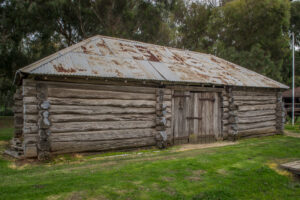Carisbrook, population 1200, is situated at the confluence of McCallums Creek and Tullaroop Creek (known locally as Deep Creek), 7 km west of Marlborough.

Carisbrook Stone Arrangement
Carisbrook is home to the Dja Dja Wurrung people who built huge stone-shaped boomerangs out of stones where they held their initiation ceremonies. About 5 km south-east of town, on the banks of

Tullaroop Creek
Tullaroop Creek, is a well-preserved Aboriginal stone arrangement measuring 60 m by 5 m. It is claimed as one of only four stone arrangements in the state and the only one of a boomerang design. The Tullaroop Creek which was a vital source of their food and other supplies and their ancient presence can still be seen on the scar trees on its banks.
Carisbrook was toward the edge of the Maryborough goldfields, but a good water supply underpinned its prosperity. In the 1850’s a flour mill, school, Anglican church, bakeries, a brewery, four hotels, brickyards and several stores were operating. The district population increased dramatically in 1863 when gold was discovered at Majorca 8km south of Carisbrook and 15 000 diggers rushed to the area.
The future Castlemaine Maryborough Rail Trail will pass through Carisbrook with its substantial station building and goods shed no longer occupied. Perhaps the large number Rail Trail visitors will encourage businesses to set up there “down the track”. Heading east from Carisbrook, after crossing the Tullaroop Creek bridge the Rail Trail enters the Moolort Plains.

Carisbrook Log Gaol
Log Gaol
Standing in the park beside Tullaroop Creek is the town’s one significant historic building. It is so well preserved it looks like a replica but the town’s log lock-up is thought to have been built around 1852 on the police paddock and moved to its present site in 1886. The walls are made of interlocking horizontally-laid logs. The shingle roof has been replaced with corrugated iron.
Tullaroop Creek Nature Trail
A well sign posted walk along the banks of the Tullaroop Creek. It is possible to see platypus (at dawn and dusk), kookaburras, gums scarred by Aboriginal axes and to begin to understand how the DJ Dja Wurrung people used it as a vital food supply.
